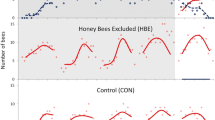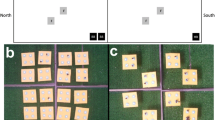Summary
This study examines whether the foraging behavior of worker bumble bees (Bombus: Apidae) collecting nectar on inflorescences of seablush (Plectritis congesta: Valerianaceae) is affected by colony energetic requirements, which were experimentally manipulated either by adding sucrose solution to honey pots or by removing virtually all available nectar from the pots. The competing hypotheses tested were: (1) no change; energetic requirements do not affect behavior, since there is a single best way to collect food in a given environment; (2) energetic currency; the energetic currency maximized by foragers changes according to colony energetic condition, with nectar-depletion causing a shift from maximizing long-term productivity to maximizing immediate energetic gain, thereby de-emphasizing energetic costs; and (3) predation; foragers devalue risk of predation as risk of starvation increaes, with colony nectar-depletion causing foragers to be less predation riskaverse in order to increase immediate energetic gain. Relative to when their colony energy reserves were enhanced, foragers from nectar-depleted colonies selected smaller inflorescences, visited fewer flowers per inflorescence, probed flowers at a higher rate while on each inflorescence, and walked between inflorescences less often, thereby spending a greater proportion of their foraging trip in flight. These behaviors increased a bee's energetic costs while foraging, and should also have increased its immediate energetic gains, allowing rejection of the no change hypothesis. Predictions of the predation hypothesis were generally not supported, and our results best support the energetic currency hypothesis. Foraging currency of bumble bees therefore appears to be a function of colony energetic state.
Similar content being viewed by others
References
Best LS, Bierzychudek P (1982) Pollinator foraging on foxglove (Digitalis purpurea): a test of a new model. Evolution 36:70–79
Caraco T, Martindale S, Whittam TS (1980) An empirical demonstration of risk-sensitive foraging preferences. Anim Behav 28:820–830
Cartar RV (1989) Condition-dependent foraging behavior of bumble bees. PhD thesis. Simon Fraser University, Burnaby, B.C., Canada
Cartar RV (1991) A test of risk-sensitive foraging in wild bumble bees. Ecology (in press)
Cartar RV, Dill LM (1990) Why are bumble bees risk-sensitive foragers? Behav Ecol Sociobiol 26:121–127
Charnov EL (1976) Optimal foraging: the marginal value theorem. Theor Popul Biol 9:129–136
Fagerstrom T, Moreno J, Carlson A (1983) Load size and energy delivery in birds feeding nestlings: constraints on an alternative strategies to energy-maximization. Oecologia (Berlin) 56:93–98
Free JB (1955) The division of labour within bumblebee colonies. Insectes Soc 2:195–212
Heinrich B (1975) Thermoregulation in bumblebees II. Energetics of warm-up and free flight. J Comp Physiol 96:155–166
Heinrich B (1979) Bumblebee economics. Harvard University Press, Cambridge, MA
Hodges CM (1981) Optimal foraging in bumblebees: hunting by expectation. Anim Behav 29:1166–1171
Hodges CM, Wolf LL (1981) Optimal foraging bumblebees: why is nectar left behind in flowers? Behav Ecol Sociobiol 9:41–44
Houston AI (1987) Optimal foraging by parent birds feeding dependent young. J Theor Biol 124:251–274
Houston AI (1990) Parent birds feeding young — To walk or to fly? J Theor Biol 142:141–147
Houston AI, McNamara JM (1988) A framework for the functional analysis of behaviour. Behav Brain Sci 11:117–130
Houston AI, Schmid-Hempel P, Kacelnik A (1988) Foraging strategy, worker mortality, and the growth of the colony in social insects. Am Nat 131:107–114
Kagel JH, Green L, Caraco T (1986) When foragers discount the future: constraint or adaptation? Anim Behav 34:271–283
Lifjeld JT (1988) Prey choice and nestling hunger: an experiment with pied flycatchers, Ficedula hypoleuca. Anim Behav 36:134–139
Mangel M, Clark CW (1988) Dynamic modeling in behavioral ecology. Princeton University Press, Princeton, NJ
McNamara JM, Houston AI (1986) The common currency for behavioral decisions. Am Nat 127:358–378
McNamara JM, Houston AI (1987) Foraging in patches: there's more to life than the marginal value theorem. In: Commons ML, Kacelnik A, Shettleworth SJ (eds) Quantitative analyses of behavior, vol 6, Foraging. Lawrence Erlbaum, Hillsdale, NJ
Morse DH (1986) Predatory risk to insects foraging at flowers. Oikos 46:223–228
Pleasants JM (1989) Optimal foraging by nectarivores: a test of the marginal value theorem. Am Nat 134:51–71
Pyke GH (1979) Optimal foraging in bumblebees: rule of movement between flowers within inflorescences. Anim Behav 27:1167–1181
Pyke GH (1980) Optimal foraging in bumblebees: calculation of net energy intake and optimal patch choice. Theor Popul Biol 17:232–246
Robinson SK (1986) Three-speed foraging during the breeding cycle of yellow-rumped caciques (Icterinae: Cacicus cela). Ecology 67:394–405
Rodd FH, Plowright RC, Owen RE (1980) Mortality rates of adult bumble bee workers (Hymenoptera: Apidae). Can J Zool 58:1718–1721
Schmid-Hempel P (1987) Efficient nectar-collecting by honeybees. I. Economic models. J Anim Ecol 56:209–218
Schmid-Hempel P, Kacelnik A, Houston AI (1985) Honeybees maximize efficiency by not filling their crop. Behav Ecol Sociobiol 17:61–66
Stephens DW (in press) Foraging theory: up, down, and sideways. In: Morrison M, Ralph CJ, Venner J (eds) Food exploitation by terrestrial birds. Studies in avian biology No. 13. Cooper Ornithological Society, LA, CA
Swennen C, Leopold MF, Bruijn LLM (1989) Time-stressed oystercatchers, Haematopus ostralegus, can increase their intake rate. Anim Behav 38:8–22
Welham CVJ, Ydenberg RC (1988) Net energy versus efficiency maximizing by foraging ring-billed gulls. Behav Ecol Sociobiol 23:75–82
Witham TG (1977) Coevolution of foraging in Bombus and nectar dispensing in Chilopsis: a last dreg theory. Science 197:593–596
Wolf TJ, Schmid-Hempel P (1989) Extra loads and foraging life span in honeybee workers. J Anim Ecol 58:943–954
Author information
Authors and Affiliations
Additional information
Offprint requests to: R.V. Cartar
Rights and permissions
About this article
Cite this article
Cartar, R.V., Dill, L.M. Colony energy requirements affect the foraging currency of bumble bees. Behav Ecol Sociobiol 27, 377–383 (1990). https://doi.org/10.1007/BF00164009
Received:
Accepted:
Issue Date:
DOI: https://doi.org/10.1007/BF00164009




